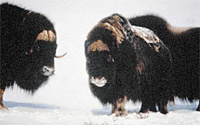



Predicting Changes for Parasite and Vector Induced Animal Diseases
Climate change could have a major influence on animal health, both directly and indirectly, by affecting the parasites and vectors that spread diseases, according to Eric Hoberg, an Agricultural Research Service (ARS) zoologist at the Agricultural Research Center in Beltsville.Climate change can alter an animal’s relationship with parasites and vectors. These changes can influence where parasites and vectors thrive, making certain geographical regions more or less amenable to them. Climate change can also alter when and for how long parasites and vectors pose a threat to agricultural animals. Climate can determine how pathogens are distributed, transmitted and evolve, and can influence the factors associated with emerging disease and how animals respond to those diseases. Significant environmental changes have been well documented in recent decades, and some of these changes are causing trouble for livestock.
Dr Eric Hoberg is one of many ARS scientists investigating the probable impact of climate changes on agricultural parasites and virus vectors. Their research is generating information that could help producers prepare for and respond to heightened disease threats.
In one study, Dr Hoberg collaborated with several Canadian scientists to investigate the influence of climate change on parasitic lungworms known as Protostrongylus stilesi in Arctic mammals. Although the lungworms had never before been observed in muskoxen, the scientists observed them in muskoxen that share habitat with Dall's sheep. Environmental changes that bring the two animals into contact more frequently could result in larger parasite populations.
"Climate change alters the boundaries between different species and between natural and managed lands," Dr Hoberg says. "When these boundaries break down, it becomes possible for pathogens to switch between hosts."
Muskoxen are not a major agricultural animal in the United States, but their interaction with lungworms and Dall's sheep could be used to establish predictive models that could help US animal producers better understand how pathogens switch between hosts.
Climate change may also influence insects that spread diseases. At the ARS Arthropod-Borne Animal Diseases Research Laboratory (ABADRL) in Laramie, Wyoming, scientists are investigating several vectored diseases, including bluetongue and Rift Valley fever (RVF).
"In recent years we've seen an incursion of bluetongue virus in Europe, but whether that's affected by climate change or not hasn't yet been determined," says ABADRL microbiologist, Bill Wilson.

Several factors influenced by climate change could explain the spread of bluetongue virus, says ABADRL entomologist, Kristine Bennett. Higher temperatures could enable Culicoides imicola, the disease's primary vector in Europe, to inhabit a much larger geographic area. Higher temperatures could enhance viral replication, potentially enabling indigenous Culicoides populations to vector the disease. And warmer winter temperatures could enable more Culicoides to survive the winter, extending their influence.
Other factors are at play in the case of RVF, a viral disease that occurs in Africa and recently has spread beyond the continent's borders into the Arabian Peninsula.
"RVF outbreaks are closely connected to cycling global climate variability caused by El Niño Southern Oscillation phenomena – particularly rainfall and flooding, which introduce the virus into livestock populations by facilitating the hatching of virus-infected mosquito eggs resting in the soil," says Ken Linthicum, director of the ARS Center for Medical, Agricultural and Veterinary Entomology in Gainesville, Florida.
"Our research hasn't focused on climate trends, but we do know that elevated sea surface temperatures, such as those associated with El Niño cycles, are related to heavy rainfall and flooding, which are related to RVF outbreaks," Dr Linthicum says.
Dr Linthicum led a team of scientists in developing a model that in 2006 successfully predicted an RVF outbreak in Africa several months before the outbreak occurred. This early warning enabled international aid organizations to increase disease surveillance and to conduct public information, animal vaccine and insect control programs. Since then, the model has predicted outbreaks in southern Africa, Sudan and the Horn of Africa. Tools like this could be essential for early detection and control of RVF, should it ever enter the United States.
Since the 1950s, ocean buoys and satellite instrument monitors have clearly documented increasing surface temperatures in the Indian Ocean. Dr Linthicum and his colleagues believe these rising temperatures and related rainfall result in more frequent, smaller outbreaks of RVF.
"When large outbreaks do occur, they tend to be bigger and more widespread than those we observed in the past," he says. This information could help policymakers mobilize outbreak response efforts.
"The potential effects of climate change are not yet fully understood," says ARS national programme leader, Cyril Gay. "But evidence suggests that animal health could be affected by rising ambient and ocean temperatures. To protect US livestock from parasite and vector-borne diseases, scientists must be engaged in research on many fronts."
Regular surveillance will provide up-to-date information about changes in pathogen populations. Laboratory and field research will help illuminate how climate changes influence pathogen characteristics, and models will help researchers and producers predict and plan for pathogen threats. With a nationwide network of research facilities and a history of groundbreaking pathogen research, ARS is well positioned to provide research, expertise and tools to address any parasite or vector-borne disease threats that arise in response to a changing global climate.
October 2009


